It is extremely rare to find perennial verbena seeds on the seed market. Despite the variety of its varieties, all offered are annuals. In Russian conditions, only one variety can overwinter - straight verbena, but it does not have the same decorative effect as its annual counterparts.And yet, the opportunity to admire this plant even in winter exists, but more on that later.
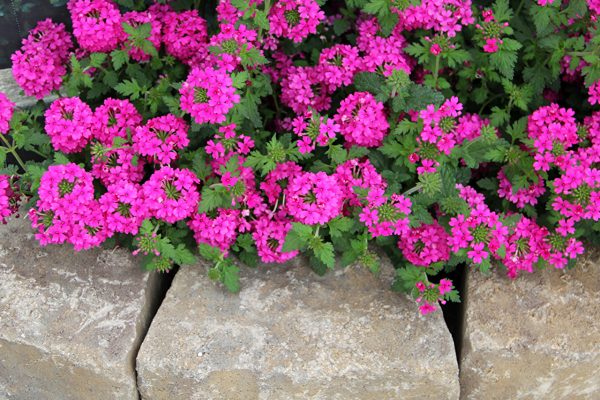
This is what verbena looks like in a flowerbed.
| Content:
|
The gardener’s task is to obtain the maximum effect from its presence on the site during the growing period of this flower. Planting and caring for verbena in open ground contains simple requirements and is not at all burdensome.
Planting verbena in the ground
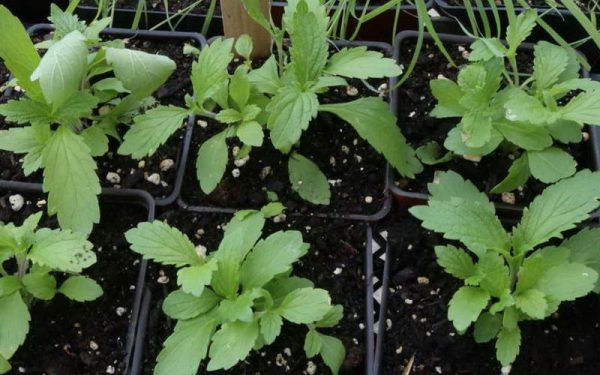
If the seeds were planted in March, then by May you will already have lush, strong bushes
1) When to plant?
The time of planting in open ground depends on the area of growth. In most regions, this is the second and third ten days of May. The absence of night frosts can serve as a guideline. The best temperature for transplanted plants is 18 - 21 degrees during the day and 14 - 17 at night. But lower night temperatures are not so bad for seedlings. They take root quite easily.
2) What places does he prefer?
Only a sunny place is suitable for verbena. There is no need to worry about lack of moisture. The flower is unpretentious and drought-resistant.
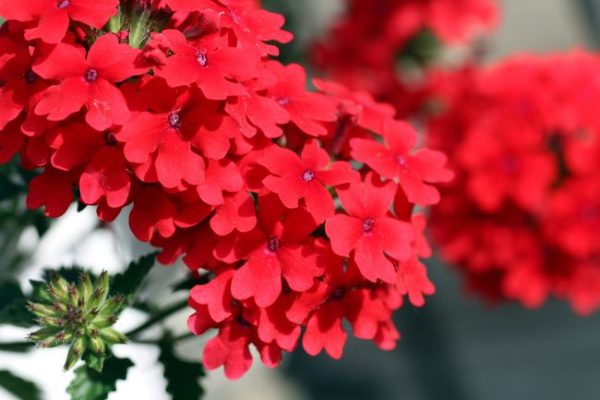
To bloom brightly, flowers must be planted in the sun.
3) What kind of soil do you like?
For planting, you need to prepare loose, well-drained soil. For this, loamy soil with humus and the addition of wood ash is suitable to neutralize the acidity of the soil.
It is necessary to add complex mineral fertilizers with a reduced nitrogen content to the flowerbed, since this element stimulates the growth of green mass to the detriment of flowering. For the same reason, you should avoid adding fresh manure.
If the soil is too dense and water stagnation is possible, then you need to arrange a drainage cushion for each plant. To do this, pour a layer of expanded clay or small stones 3–4 cm thick onto the bottom of the planting hole.
4) Landing scheme
The distance between seedlings depends on the variety of verbena. Bush varieties are planted at intervals of 20 cm; hanging varieties require at least 25 cm. It is necessary to take into account that the long branches of the flower can grow and form a continuous carpet. To do this they need sufficient space. The most optimal in this case would be an interval of 30 cm.
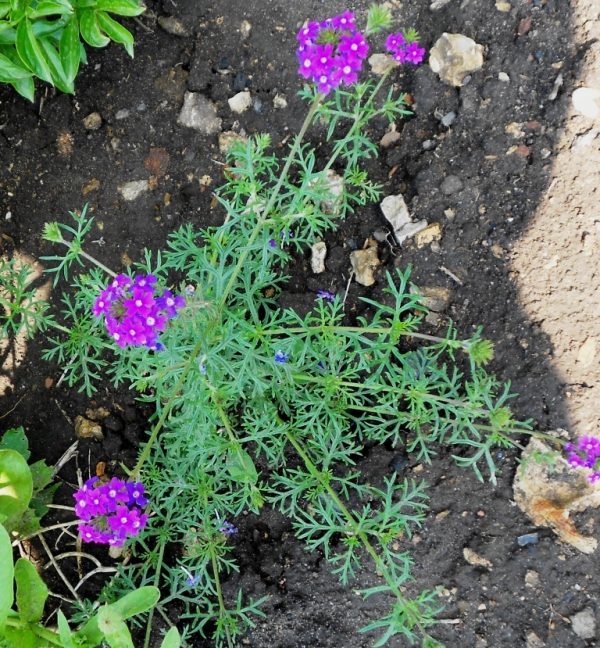
This bush was planted with the prospect of rooting vines
Landing consists of a number of sequential actions:
- Choose a sunny place on the site and mark a flower bed.
- Dig it up and achieve the desired soil composition by adding humus, wood ash and mineral fertilizers.
- Determine the planting locations in the flowerbed taking into account the plant variety.
- Dig holes at intervals. The depth of the hole depends on the need for drainage and the volume of the cup with seedlings.
- If necessary, place drainage material at the bottom of the hole, cover it with a layer of soil, water it, place the seedlings, cover it with soil and lightly compact it.
- When the entire flowerbed is filled, water the plants again using a watering can. Mulching with peat, humus or wood chips will allow you to retain moisture longer and use less watering. This is important because excess water is harmful to verbena.
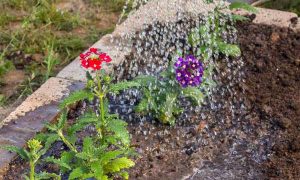 Do not forget to water the planted verbena seedlings well. |
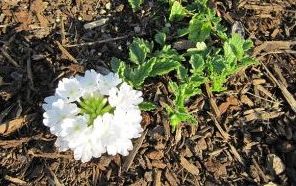 Mulching the flower bed helps retain moisture. |
Caring for verbena in open ground
In open ground, verbena requires only the most necessary care:
Watering
Watering is moderate, without waterlogging.
Feeding
Feeding - 3 - 4 times per season.In order to prolong the flowering period and maintain a more decorative appearance of the plant, it is better to use a complex mineral fertilizer of prolonged action.
Loosening
Loosening is required if the soil around the flower is not mulched. Breaking up the resulting crust helps provide oxygen to the roots, retain moisture, and remove weeds.
Pinching
Not all flowers need pinching. There are many varieties that form neat bushes on their own, for example the Quartz series.
Pinching hybrid verbena above the 3rd - 4th leaf stimulates the formation of additional shoots and growth of the plant. The long lashes of the flower can be attached to the ground with a pin and spudded. In this place, the whip takes root, and a flowering carpet is formed from just one plant.
Trimming faded inflorescences allows you to preserve the decorative effect and ensures the splendor of flowering.
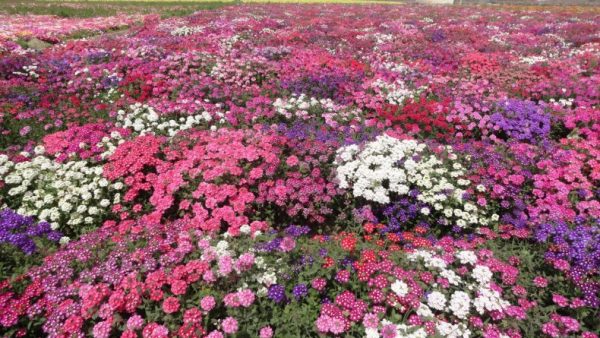
Such a carpet of verbenas is obtained when the plants are properly planted and properly cared for.
Verbena propagation by cuttings
Verbena easy propagated by cuttings. As a mother plant, you can use either a young plant or last year’s plant that overwintered indoors.
For the cutting you need to take a side shoot, preferably without buds and located closer to the root. Its length should be about 10 cm. After cutting, place the cutting in Kornevin or Epin solution, then plant it in a glass with light nutritious soil, the same as for seedlings. There should be several holes in the bottom of the cup.
If rooting is planned in open ground, then you need to choose a place in the shade, bury the glass in the ground, cover the top with a plastic bottle with the bottom cut off and the neck open.Within a month, it is necessary to regularly but moderately water the cuttings. After 25–30 days, a new plant will be ready for planting in open ground, completely replicating all the qualities of the mother plant.
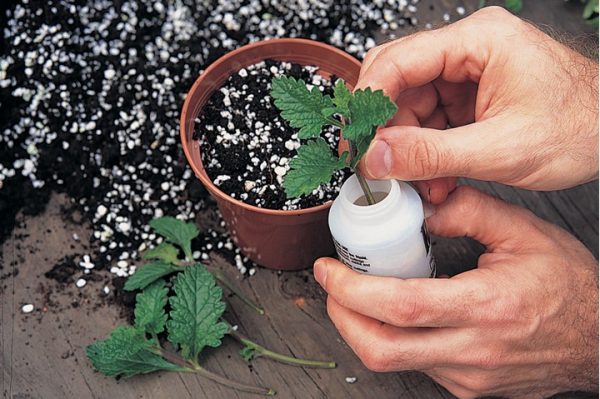
Propagation of verbena by cuttings.
Cuttings can also be taken from verbena that has overwintered at home. In this case, they can be rooted from February to early March. You will need the upper branches of the plant 10 - 12 cm long, cups with soil, a box or container and plastic film.
Cut off the lower leaves from the cuttings, place them in a solution of a root former or growth stimulator, then plant them in cups with soil and water them. Place all the cups in a container and build a greenhouse over it from plastic film.
Caring for seedlings consists of moderate watering, regular ventilation and lighting. By the end of the month, the film can be removed and cared for before planting in the ground, as with ordinary seedlings.
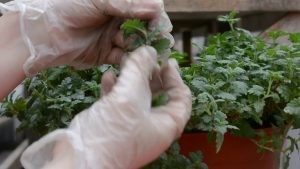 We cut off the shoot from the mother plant. |
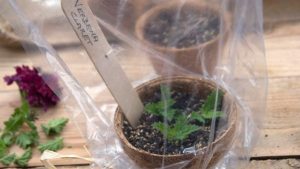 We plant the cuttings under the film. |
Planting ampelous verbena in flowerpots and flowerpots
Ampel verbena is distinguished by its versatility. It is easy to make a grassy lawn from it by rooting long vines, but it looks especially beautiful in flowerpots and flowerpots.
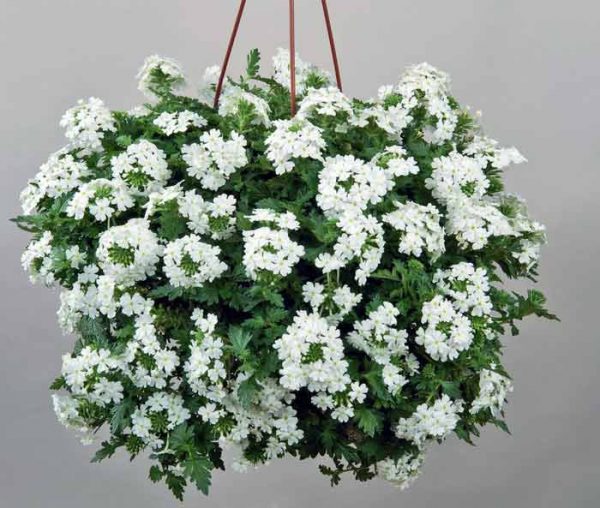
Ampelous verbena in a flowerpot.
This flower does not require a large container, since the roots are located superficially. The most important thing is to prevent water from stagnating, so you need to put a good drainage layer of expanded clay or small stones on the bottom.
The soil is prepared with light nutritious neutral acidity. You can use ready-made soil for flower plants or mix sand, garden soil, peat yourself in a ratio of 0.5:1:2, add complex fertilizer and wood ash.
It is better to plant ampelous verbena alone in a flowerpot, since the volume is relatively small, and several different flowers can be placed in flowerpots. Upright specimens (geranium, fuchsia, begonia) combine very beautifully with lush hanging branches of verbena. Although, compositions with hanging plants are no less interesting.
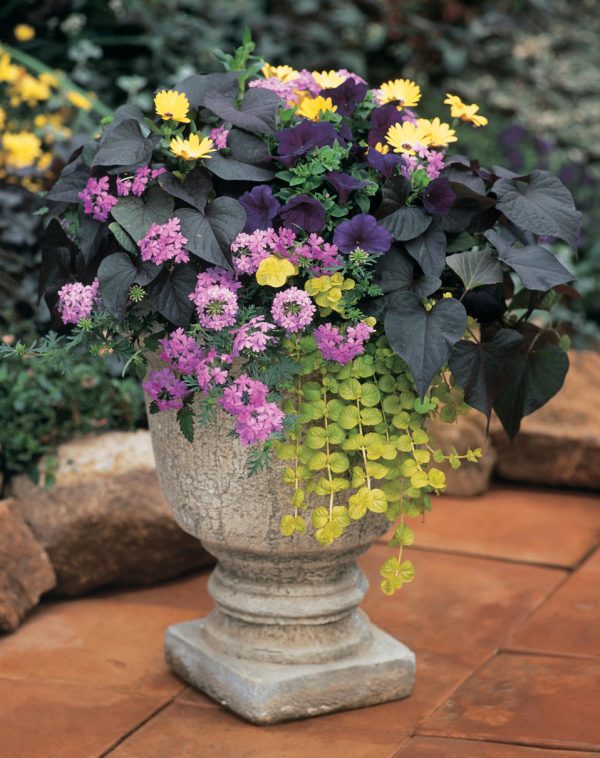
Verbena grows well in flowerpots.
Most varieties of ampelous verbena are drought-resistant, do not require close attention, bloom profusely and for a long time, and can withstand even the first frosts.
Planting and caring for verbena on the balcony
Not every balcony is suitable for planting and growing verbena. This plant is light-loving, so only the sunny side of the house can be decorated with it.
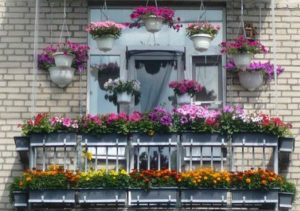 Blooming balcony. |
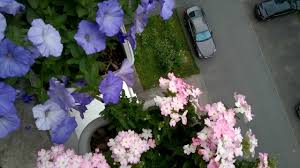 Flowers grow high above the ground. |
The best variety for balcony gardening is ampelous verbena of the Imagination series. It is most adapted to growing in a container or hanging pot. Planting requires a container, material for drainage, soil of neutral acidity and a loose structure.
The container must have a sufficient number of holes to drain excess liquid. It is necessary to place a drainage layer 3–4 cm thick at the bottom, fill it with soil, plant a seedling and water it well.
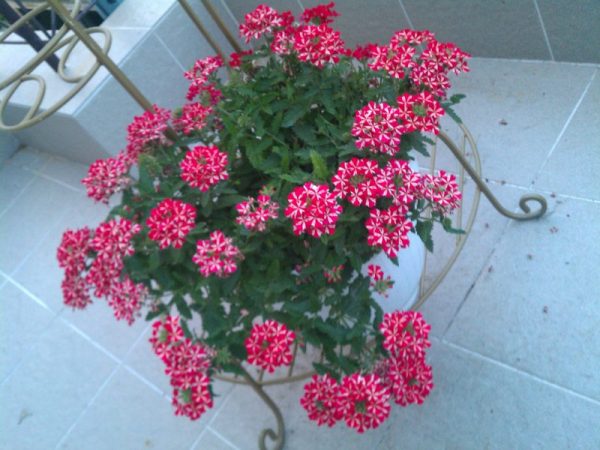
It is better to plant only one plant in a pot
It is better to grow only verbena in flowerpots, since even one plant produces lush hanging branches up to 60 cm long. In balcony boxes you can create various compositions with nasturtiums, petunias, pelargonium and other plants.
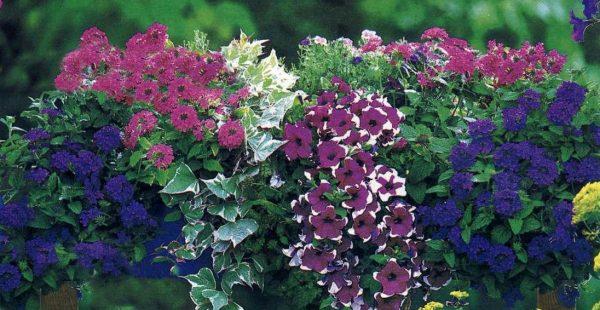
Composition of petunia and verbena.
Caring for balcony verbenas:
- regular moderate watering with the addition of complex mineral fertilizers every two weeks,
- pruning branches to ensure the bush is full,
- removing faded inflorescences to add decorativeness and stimulate bud formation,
- ensuring a temperature of at least +15 degrees when cold weather sets in.
Diseases and pests
Modern breeding has made a great contribution to the creation of decorative varieties of verbena that are resistant to various diseases, but still some diseases should be feared. The most common diseases are powdery mildew and root rot.
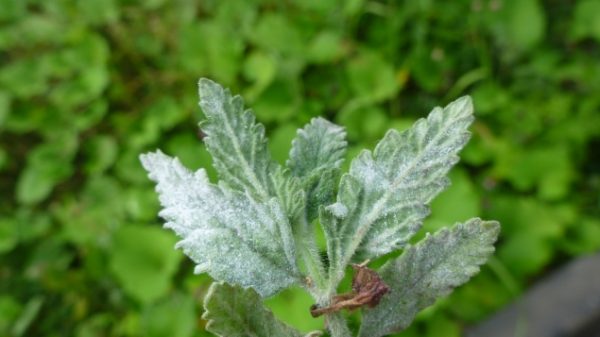
Powdery mildew.
First sign powdery mildew – the appearance of white spots on the leaves. Later the leaves turn purple and die. The disease is treatable if started on time. The affected leaves must be cut off and burned, and the plant treated with a fungicide solution: Fundazol, Chistotsvet, Strobi, Raek. These drugs have different effects, they need to be alternated so that the pathogens of powdery mildew do not develop resistance.
Root rot occurs in verbena when the soil is waterlogged and has poor drainage. The stem begins to turn black, the plant withers and it is no longer possible to save it. The diseased specimen should be removed, watering should be reduced, and healthy flowers should be treated with Fitosporin, Baikal EM - 1, Trichodermin, etc.
The most common pests are aphids and spider mites. While aphids can be noticed early and treatment can begin, spider mites are often discovered too late. The pest is very aggressive, reproduces quickly, and is capable of developing resistance to many drugs.
 Aphid |
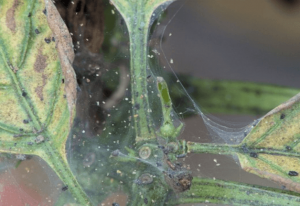 Spider mite. |
First, yellow dots appear on the leaves of the plant - bite marks; later the leaves turn completely yellow and dry out. On the reverse side of the leaf you can see a web and numerous mobile individuals and larvae. The damage quickly spreads not only to the entire plant, but also to neighboring flowers, so urgent measures are needed.
Actellik, Intavir, Agravertin, etc. will help against aphids, and the drugs Akarin, Bitoxibacillin, Fitoverm, etc. will defeat spider mites. Treatments must be carried out in accordance with the instructions, the drugs should be alternated to obtain a greater effect.
What colors does it go with?
There are a huge number of options for using verbena in landscape design. It is beautiful in solo plantings, in mixed borders, and as a design element. ornamental shrubs, and in flowerpots... The main thing is to choose the right color scheme.
In ampelous verbena, when used as ground cover, sometimes branches closer to the root are exposed. A compact petunia will help here, and the composition will always be decorative. Traditional asters and marigold will take on an original look surrounded by a magical flower.
Upright varieties of verbena look very elegant with nasturtium, surfinia, and purslane. Flowerpots in pots are good on their own, but in a flowerpot they need to be combined with sun-loving flowers like them.
For landscaping a balcony there are also many plants that can accompany verbena: dichondra, begonia, aeschynanthus, bacopa and many others. All options are good, and flower growers will always benefit, since verbena blooms from June to September.
How to collect and store seeds?
To collect seeds, you need to choose the inflorescences you like and leave them to bloom on the bush. After flowering, boxes are formed, which turn brown when ripe, then the inflorescence must be cut off and dried indoors. Place dry seeds in a paper bag and store at room temperature.
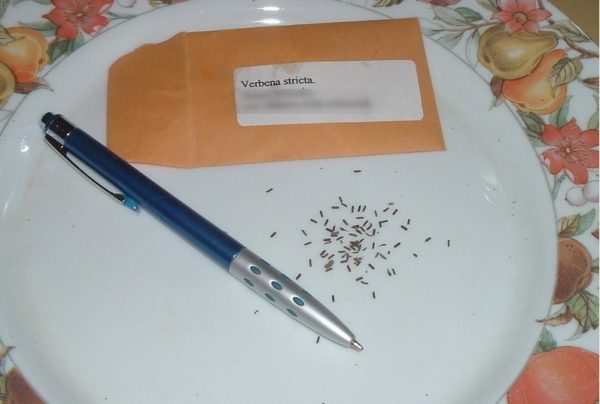
Verbena seeds.
Germination remains up to five years, but it must be remembered that flowers with maternal qualities do not always grow from collected seeds.
How to preserve a verbena bush in winter?
Verbena is so loved by flower growers that you don’t want to part with it even in winter. The bush can be stored indoors until next spring, but it will not bloom at home, since he needs to create a period of rest for the winter.
Before the onset of cold weather, the plant you like is cut in half, carefully dug up and, together with a lump of earth, placed in a container. Verbena should overwinter in a bright but cool room, no higher than +15 degrees. This could be an insulated balcony or veranda. If inflorescences appear on the verbena, they need to be removed and the shoots shortened.
By the end of February, the bush is transplanted into fresh soil, transferred to warmth and provided with sufficient light. The flower begins to develop quickly. It can be used as a mother plant for cuttings or planted on the site in the spring. Overwintered verbena blooms much earlier than seedlings. By repeating this procedure annually, you can preserve the same bush for up to eight years.
There are very few flowers as trouble-free and beautiful as verbena. For gardeners, this is an easy and pleasant option for decorating their plot. And if we also take into account the mystical qualities of this magical flower, then its value increases significantly. After all, the more verbena there is around, the calmer, cleaner and richer our life will be.
Continuation of the topic:
- Growing verbena from seeds at home
- Features of growing ampel verbena
- The most popular and beautiful varieties of verbena
- Verbena photo
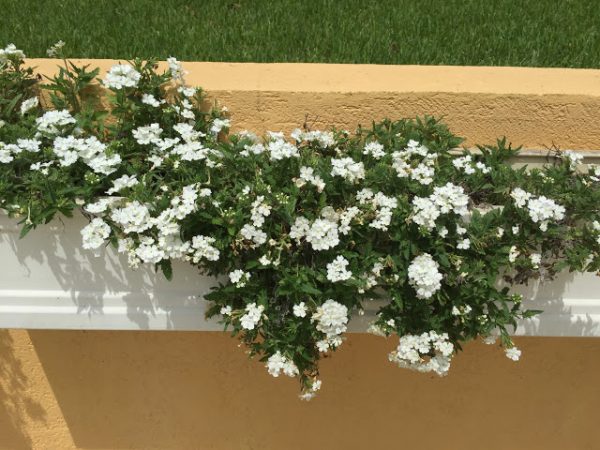

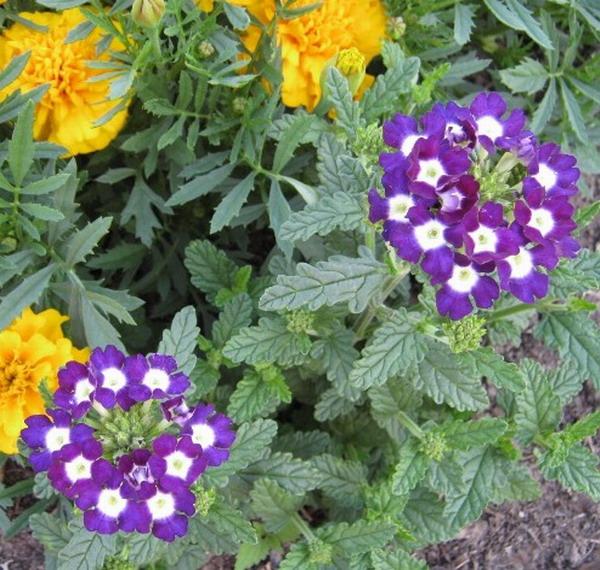
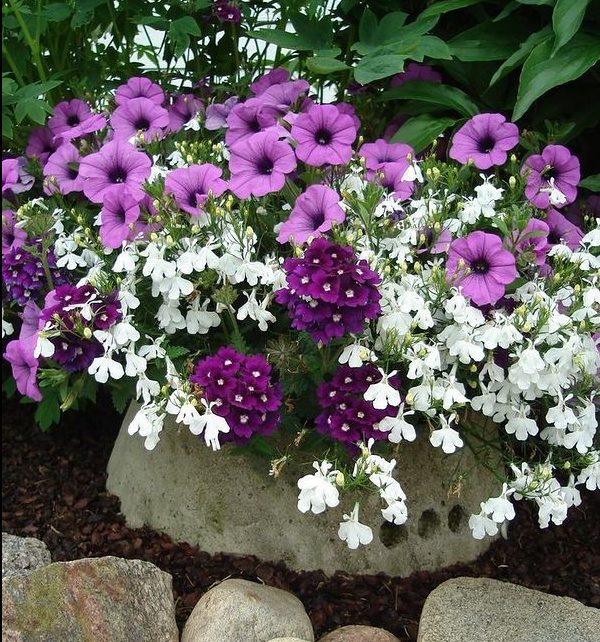
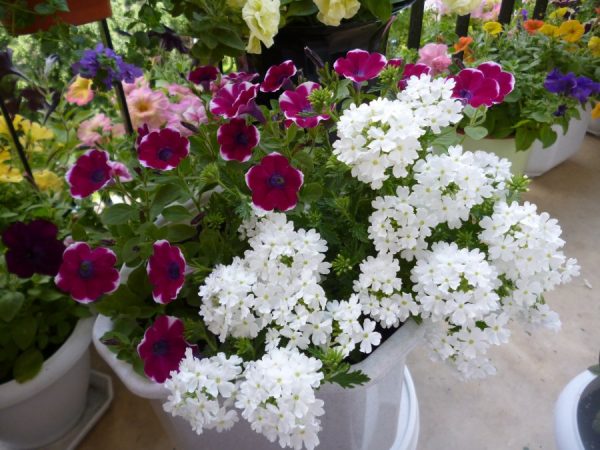
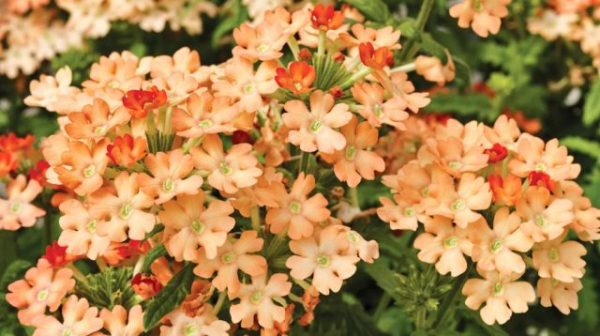

 CUCUMBERS NEVER GET SICK, I'VE BEEN USING ONLY THIS FOR 40 YEARS! I SHARE A SECRET WITH YOU, CUCUMBERS ARE LIKE THE PICTURE!
CUCUMBERS NEVER GET SICK, I'VE BEEN USING ONLY THIS FOR 40 YEARS! I SHARE A SECRET WITH YOU, CUCUMBERS ARE LIKE THE PICTURE! You can dig a bucket of potatoes from each bush. Do you think these are fairy tales? Watch the video
You can dig a bucket of potatoes from each bush. Do you think these are fairy tales? Watch the video
 How our fellow gardeners work in Korea. There is a lot to learn and just fun to watch.
How our fellow gardeners work in Korea. There is a lot to learn and just fun to watch. Eye trainer. The author claims that with daily viewing, vision is restored. They don't charge money for views.
Eye trainer. The author claims that with daily viewing, vision is restored. They don't charge money for views. A 3-ingredient cake recipe in 30 minutes is better than Napoleon. Simple and very tasty.
A 3-ingredient cake recipe in 30 minutes is better than Napoleon. Simple and very tasty. Therapeutic exercises for cervical osteochondrosis. A complete set of exercises.
Therapeutic exercises for cervical osteochondrosis. A complete set of exercises. Which indoor plants match your zodiac sign?
Which indoor plants match your zodiac sign? What about them? Excursion to German dachas.
What about them? Excursion to German dachas.